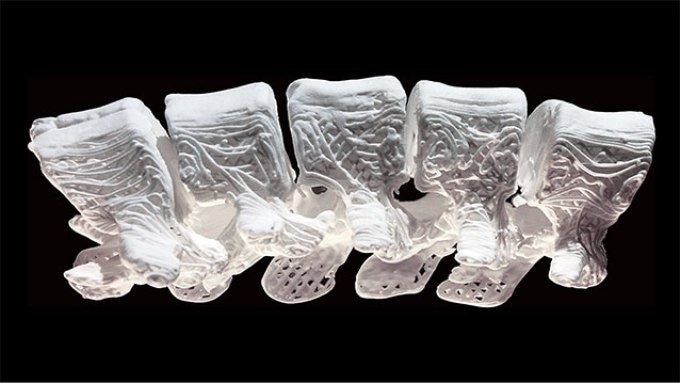Sep 30 2016
 A hyperelastic bone in the shape of a section of the human spine, 3-D printed using an ink developed at Northwestern University. Credit: Adam E. Jakus
A hyperelastic bone in the shape of a section of the human spine, 3-D printed using an ink developed at Northwestern University. Credit: Adam E. Jakus
A 3D printable ink has been developed by a group of researchers from Northwestern University. This 3D printable ink is capable of developing a synthetic bone implant that can rapidly induce bone growth and regeneration. The shape of this hyperelastic bone material can be customized, and could one day be used to treat bone defects in children.
Bone implantation surgery is definitely a challenging task, and performing implantation surgeries on children can be more painful and complicated. For adults and children, bone is often harvested from some other part of the body to replace the missing bone. This procedure can cause pain and other complications. Although metallic implants are used sometimes, it does not serve as a solution for growing children.
Adults have more options when it comes to implants. Pediatric patients do not. If you give them a permanent implant, you have to do more surgeries in the future as they grow. They might face years of difficulty.
Ramille N. Shah, Assistant Professor, Northwestern University
The main goal for Shah and her team is to change the nature of bone implants and make it more pediatric-friendly. Shah is an assistant professor of materials science and engineering in Northwestern’s McCormick School of Engineering and of surgery in the Northwestern University Feinberg School of Medicine.
The new study that examines the material within animal models and human stem cells has been published in the recent issue of the journal Science Translational Medicine. The first author of the paper is Adam E. Jakus, a postdoctoral fellow in Shah’s laboratory.
The 3D printed biomaterial developed by Shah’s team is a combination of biodegradable, biocompatible polymer used in various medical applications including sutures, and hydroxyapatite, a calcium mineral that is naturally present in human bone.
The hyperelastic “bone” material has demonstrated immense potential in ‘in vivo’ animal models. This achievement is due to the unique properties of the 3D printed structure. Despite being mostly hydroxyapatite, the material is hyperelastic, porous, and robust at the macro, micro, and nano levels.
Porosity is huge when it comes to tissue regeneration, because you want cells and blood vessels to infiltrate the scaffold. Our 3-D structure has different levels of porosity that is advantageous for its physical and biological properties.
Ramille N. Shah, Assistant Professor, Northwestern University
Although hydroxyapatite promotes bone regeneration, it is very complicated to work with. Clinical products that employ calcium phosphate ceramics, including hydroxyapatite, are brittle and hard. In order to offset this issue, researchers in the past developed structures that mainly included polymers, but this shields the bioceramic activity.
In contrast, Shah’s bone biomaterial is just 10% by weight polymer and 90% by weight hydroxyapatite, and still it was able to maintain its elasticity due to the way its structure was designed and printed. A unique environment was created by high concentration of hydroxyapatite, promoting rapid regeneration of bones.
Cells can sense the hydroxyapatite and respond to its bioactivity. When you put stem cells on our scaffolds, they turn into bone cells and start to up-regulate their expression of bone-specific genes. This is in the absence of any other osteo-inducing substances. It’s just the interaction between the cells and the material itself.
Ramille N. Shah, Assistant Professor, Northwestern University
However, this does not mean that other substances could not be incorporated into the ink. Since the 3D printing process is carried out at room temperature, Shah’s research team successfully integrated antibiotics and other elements into the ink.
The ability to customize the product to the patient is one of the biggest advantages. Traditional bone transplant surgeries involve shaping and molding the bone taken from another part of the body to fit it exactly to the area where it is required. With Shah’s synthetic material, physicians can now create personalized 3D printed products by scanning the patient’s body. Alternatively, it also possible to trim and cut the biomaterial into the required size and shape during a procedure, thanks to its attractive mechanical properties.
Shah envisages that hospitals may someday have 3D printers capable of printing customized implants while patients wait.
“The turnaround time for an implant that’s specialized for a customer could be within 24 hours,” Shah said. “That could change the world of craniofacial and orthopaedic surgery, and, I hope, will improve patient outcomes.”